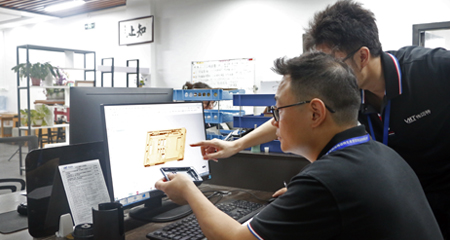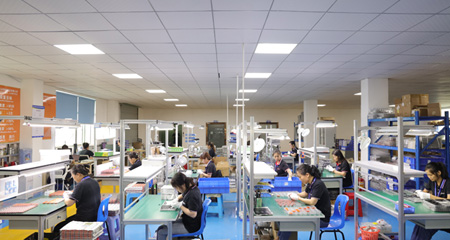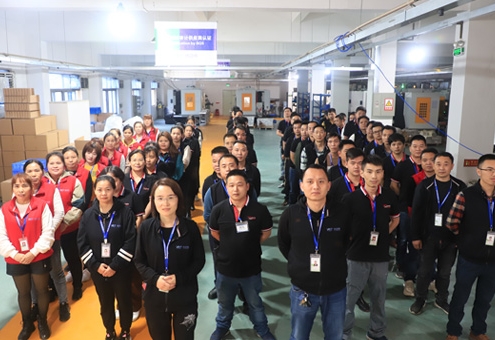How to Ensure the Consistency of Part Size for Large Batches of Parts?
The demand for high-volume production of precision CNC machining parts is ever-growing, yet maintaining exact dimensional consistency across thousands or even millions of units remains a significant challenge. Inconsistent part sizes can lead to costly reworks, assembly failures, and ultimately, damage your product’s reputation. You need a manufacturing partner who understands these complexities and employs a robust, systematic approach to quality assurance.
We understand that true precision isn’t just about hitting a tolerance on a single part; it’s about replicating that accuracy consistently, every single time. Our comprehensive 12-stage quality control system is meticulously designed to eliminate variations and guarantee the dimensional uniformity your large-batch projects demand.
The Challenge of Large-Batch Consistency in CNC Machining
Producing a single prototype with high precision is one feat; manufacturing thousands of identical, complex components is entirely another. Factors like tool wear, material variations, thermal expansion, and machine vibration can subtly introduce deviations over time. Without stringent controls, these minor inconsistencies accumulate, leading to significant yield losses and compromised product performance.
You face the daunting task of ensuring every component fits perfectly and performs as intended. This requires a partner with not only advanced machinery but also a deep understanding of process control and an unwavering commitment to quality at every stage.

VMT’s Holistic Approach to Dimensional Precision
As a leading CNC machining manufacturer in Shenzhen, ly-machining integrates extensive experience with state-of-the-art technology to address the challenges of large-batch consistency. Our 5000 square meter facility is engineered for optimal production flow, supporting a dedicated team of 100 professionals who manage a monthly output valued at 9 million RMB.
We operate 55 CNC machining centers, including advanced 3-axis, 4-axis, and 5-axis/3+2 axis Fanuc systems, alongside 25 turning and mill-turn centers. This extensive equipment, complemented by 20 Swiss-type automatic lathes and 20 auto lathes, provides the capacity and versatility required for high-volume precision manufacturing. We routinely achieve dimensional tolerances of ±0.02mm for CNC parts and ±0.01mm for turned parts, capable of reaching an exceptional ±0.005mm for critical local dimensions and 0.01mm for geometric tolerances.
Phase 1: Pre-Production – Laying the Foundation for Consistency
The journey to consistent part size begins long before a single chip is cut. Meticulous planning and precise engineering are crucial.
1. Collaborative Design for Manufacturability (DFM) Review
Your project engineer works hand-in-hand with our sales team to clarify all technical and standard requirements. This includes detailing specifications not explicitly stated on drawings or in initial communications. This proactive engagement identifies potential manufacturing challenges early, preventing costly issues down the line.
We offer free DFM expert consultations, ensuring your designs are optimized for efficient, high-precision production.

2. Identifying Critical Dimensions and Processes
Before any order review commences, our project engineer meticulously identifies and highlights all key dimensions and critical processes. This focused approach ensures that the most sensitive aspects of your part’s design receive the highest level of scrutiny throughout production.
3. Engineering Internal Production Specifications
Our process engineers translate your technical drawings into detailed internal production blueprints. These internal standards are often more stringent than your stated requirements, ensuring that our in-house production targets consistently exceed customer expectations for dimensional accuracy.
This step creates a robust internal benchmark, driving higher precision.
4. Rigorous Incoming Material Quality Control (IQC)
All raw materials undergo a comprehensive Incoming Quality Control (IQC) inspection upon arrival. Following strict process flow charts and inspection standards, only materials that meet our exacting quality criteria are approved and moved to our warehouse.
This ensures that the foundation of your parts is consistently of the highest quality.
Laying a strong foundation through DFM, precise specification engineering, and rigorous IQC is paramount for achieving part size consistency from the outset.
Phase 2: In-Process Production – Maintaining Precision at Every Step
Once production begins, continuous monitoring and precise execution are vital for upholding dimensional consistency.
5. Advanced Programming for Dimensional Integrity
Our programming engineers meticulously review key chain dimensions and process flows. They determine critical reference dimensions and crucial chain matching dimensions, optimizing the CNC program to minimize cumulative errors and maximize accuracy across all parts.
Precise programming is fundamental to repeatable results.
6. Machine Setup and Capability Verification (CPK)
Machine technicians conduct thorough commissioning according to established procedures. A primary focus at this stage is to confirm the CPK (Process Capability Index) of key dimensions. This statistical measure ensures that our machines are capable of consistently producing parts within the specified tolerances. High CPK values demonstrate inherent process stability.
7. First-Article Inspection (FAI) and Approval
The Initial Production Quality Control (IPQC) team conducts a comprehensive first-article inspection based on the internal factory drawings. Only after all involved parties, including engineering and quality assurance, approve the first article, is mass production authorized to proceed.
This critical step validates the entire setup before full production.
8. Continuous In-Process Quality Control (IPQC)
During mass production, our IPQC team conducts regular line inspections every two hours. This constant vigilance allows for immediate detection and correction of any deviations, ensuring that dimensional consistency is maintained throughout the entire production run.

9. Pre-Surface Treatment Quality Check (FQC)
Before any surface treatment is applied, the Final Quality Control (FQC) team performs a random inspection. This check specifically verifies the appearance and critical dimensions of the parts, catching any subtle issues before they become permanently masked by finishing processes.
Through advanced programming, rigorous machine capability verification, first-article approval, and continuous IPQC, we actively control dimensional consistency throughout the manufacturing process.
Phase 3: Post-Production – Final Assurance and Continuous Improvement
The commitment to quality extends beyond manufacturing, encompassing final inspection, reliability testing, and a cycle of continuous improvement.
10. Comprehensive Outgoing Quality Control (OQC)
After all surface treatments are completed, the Outgoing Quality Control (OQC) team conducts a full, 100% inspection of every single part. This final, thorough check ensures that every component leaving our facility meets your precise specifications, including critical dimensions and cosmetic requirements.
We leverage a network of over 50 SQE-approved professional surface treatment factories, ensuring consistent finishing quality. Our expertise includes addressing complex issues like managing dimensional pre-allotment for hard anodizing and implementing systemic solutions for common challenges like material flow lines and splotching on 7075 aluminum.
11. Performance and Reliability Testing (QA)
Based on your specific customer requirements, our Quality Assurance (QA) team performs component reliability testing. This can include assessments like sweat resistance and salt spray resistance, verifying the long-term performance and durability of the parts under various conditions.
This confirms both dimensional and functional consistency.
12. Data-Driven Continuous Improvement (QE)
Our Quality Engineering (QE) team plays a vital role in analyzing process data and addressing any anomalies. They implement a continuous improvement cycle, using insights gained from production data to refine processes and prevent future issues, consistently enhancing overall quality and consistency.
This commitment ensures our processes are always evolving for the better. Final OQC, comprehensive QA testing, and a proactive QE cycle complete our quality assurance, ensuring both product quality and ongoing process optimization.
Partnering with VMT for Consistent Quality
When you choose VMT as your CNC machining partner, you’re investing in a commitment to unparalleled precision and consistency for your large-batch orders. Our robust 12-stage quality control system, coupled with advanced equipment and expert personnel, ensures that every part we deliver meets your exact specifications, every single time.
We understand the criticality of your intellectual property, offering strict NDA agreements. Our flexible payment options and a “4-8-24” problem response mechanism ensure a smooth and responsive partnership.




